How to Scrape Smart Devices Data from Home Depot?
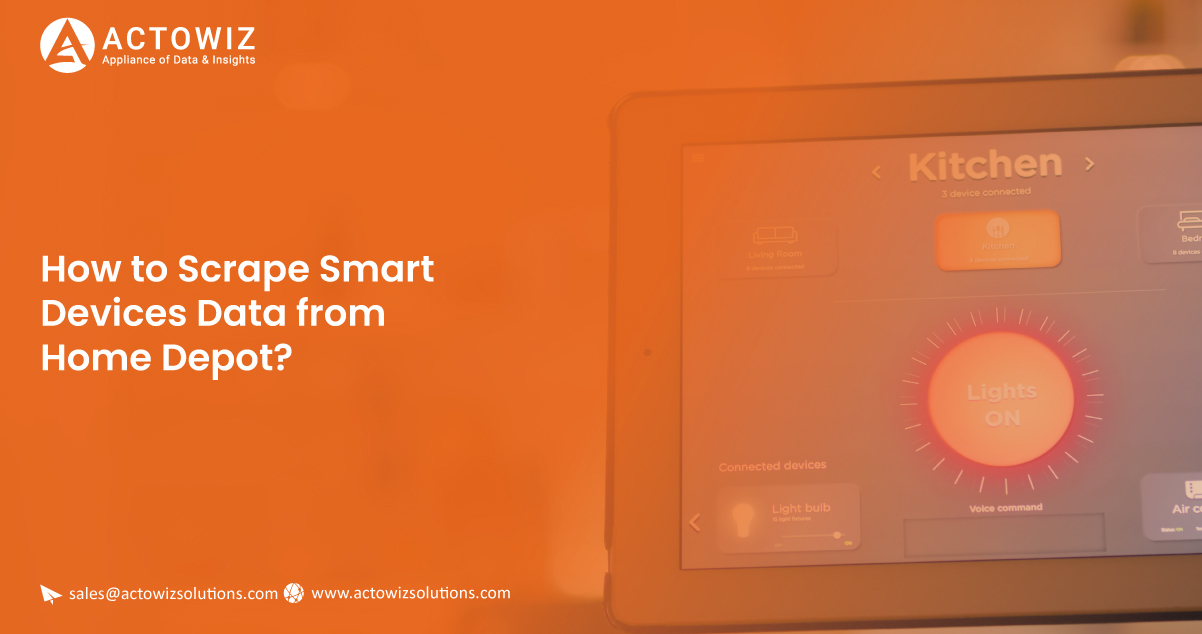
Introduction
Web scraping has emerged as a powerful tool for collecting data from websites. In today’s digital age, the ability to extract product information from online retailers is of great value. Suppose you’re interested in gathering data on smart devices. In that case, Home Depot is a prime source with a vast selection of home improvement products, including a wide range of smart devices, from thermostats to security cameras.
This guide will walk you through scraping smart device data from the Home Depot website. Whether you’re a tech enthusiast looking to stay updated on the latest smart home gadgets, a reseller seeking product information, or a data analyst interested in market trends, web scraping can provide the data you need.
Scraping data from websites like Home Depot allows you to access real-time product details, prices, availability, customer reviews, and specifications. It empowers you to make informed purchasing decisions, analyze market trends, and gain insights into consumer preferences. Moreover, this data can be invaluable for competitive analysis, price monitoring, and market research, enabling businesses to stay ahead in the ever-evolving smart device industry.
In the following sections, we will provide step-by-step guidance on how to set up a web scraping project to collect smart device data from Home Depot effectively and efficiently.
Essential Data Fields for Web Scraping Home Depot
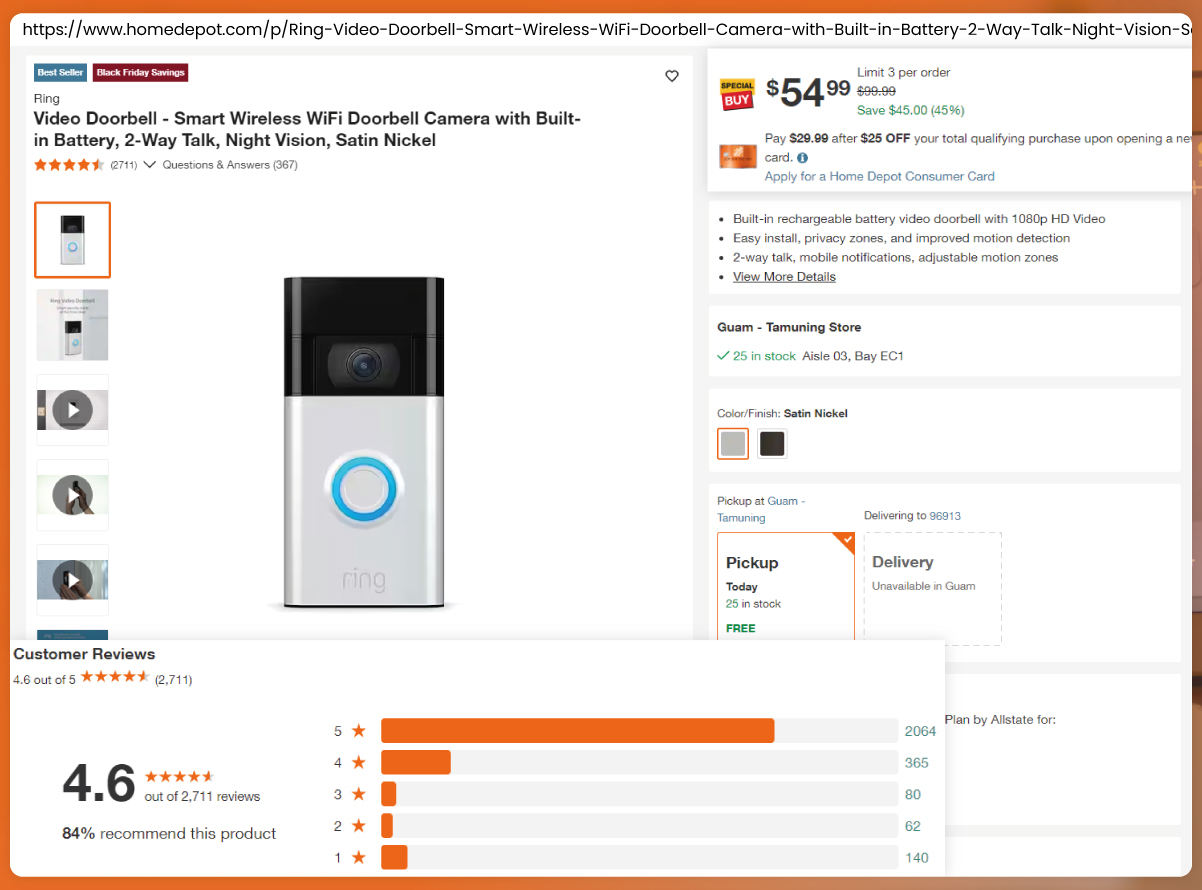
When scraping Home Depot for product data, understanding the key attributes you can extract is crucial. These attributes provide valuable information about the products you’re interested in, such as smart devices. Let’s explore some of the essential attributes you can collect:
Product Name: The product’s name is the first information you’ll want to scrape. It helps identify the item and is often used for search and categorization.
Product Description: The description details the smart device’s features, functionality, and specifications. It’s crucial to understand what the product offers.
Price: The price of the smart device is a vital attribute. It allows you to monitor pricing changes, identify discounts, and make informed purchase decisions.
Availability: This attribute indicates whether the product is in or out of stock. Both consumers and resellers need to know the availability status.
Customer Ratings and Reviews: Customer reviews and ratings offer insights into the product’s quality, performance, and user satisfaction. Scraping this data can help you gauge the product’s reception in the market.
Brand and Manufacturer: Identifying the brand or manufacturer of a smart device is valuable information. It can influence purchasing decisions and help you categorize and compare products.
Model Number: The model number provides a unique identifier for the product, making it easier to distinguish between similar items and perform specific searches.
Specifications: Specifications include technical details, such as dimensions, weight, power requirements, and compatibility. These details are essential for consumers and businesses looking for specific features.
Shipping Information: Information about shipping options, delivery times, and fees can be scraped. This helps users assess the convenience and cost of acquiring the product.
Images: Scraping product images allows you to visualize the smart device. Images are essential for product listings and can help with marketing and visual analysis.
Product URL: Collecting the product’s URL is crucial for referencing and linking to the product page, making it easier to revisit or share the product with others.
Categories and Tags: Identifying the categories and tags assigned to the product can help you organize and categorize your data effectively.
Scraping these attributes from Home Depot’s product listings provides a comprehensive dataset for smart devices. With this information, you can make informed decisions, track market trends, and conduct competitive analysis. Keep in mind that web scraping should always be done in compliance with Home Depot’s terms of service and ethical web scraping guidelines.
Setting Up Essential Libraries for Data Scraping
To embark on a successful web scraping journey for Home Depot, you’ll need to import specific libraries that streamline the process and equip you with the necessary tools for data extraction. Python is a popular choice for web scraping due to its versatility and many libraries tailored for this purpose. Here’s a guide on importing the required libraries to scrape Home Depot effectively:
1. Requests Library
Start by importing the requests library. This library lets you send HTTP requests to Home Depot’s website and retrieve the HTML content of the pages you intend to scrape. It’s an essential component for web scraping in Python.
import requests 2. Beautiful Soup:
Beautiful Soup is a Python library that helps parse HTML and XML documents. It allows you to navigate and search the HTML structure of web pages, making it easier to extract specific data elements.
from bs4 import BeautifulSoup 3. Selenium (Optional)
In some cases, Home Depot may use JavaScript to load dynamic content. If you encounter such situations, the Selenium library can be beneficial. Selenium provides a web testing framework that can automate browser interactions, allowing you to access dynamically loaded content.
from selenium import webdriver 4. Pandas
Once you’ve scraped data from Home Depot, you’ll want to organize and store it efficiently. The Pandas library is a powerful tool for data manipulation and analysis. It allows you to create data frames and work with structured data seamlessly.
import pandas as pd 5. CSV (Optional)
If you plan to save the scraped data as a CSV file, you can import the csv library. This is useful for exporting the data for further analysis or sharing with others.
import csv 6. Other Libraries (As Needed)
Depending on your specific scraping requirements, you may need additional libraries for tasks such as handling regular expressions (re-library), dealing with time and dates (datetime library), or automating repetitive tasks (schedulers like APScheduler). Import these libraries as necessary for your project.
By importing these libraries, you’ll have the foundational tools to set up your web scraping project for Home Depot. Remember that web scraping should always be performed according to Home Depot’s terms of service and ethical guidelines. Additionally, consider the possibility of rate limiting, and always respect the website’s policies to ensure responsible and legal scraping practices.
Initiating Web Scraping for Smart Devices: The Setup Phase
The initialization process for scraping smart device data from Home Depot involves setting up your environment and writing code to access the website and retrieve the desired information. Here’s a simplified example using Python and the Beautiful Soup library for web scraping. Please note that web scraping should follow Home Depot’s terms of service and ethical guidelines.
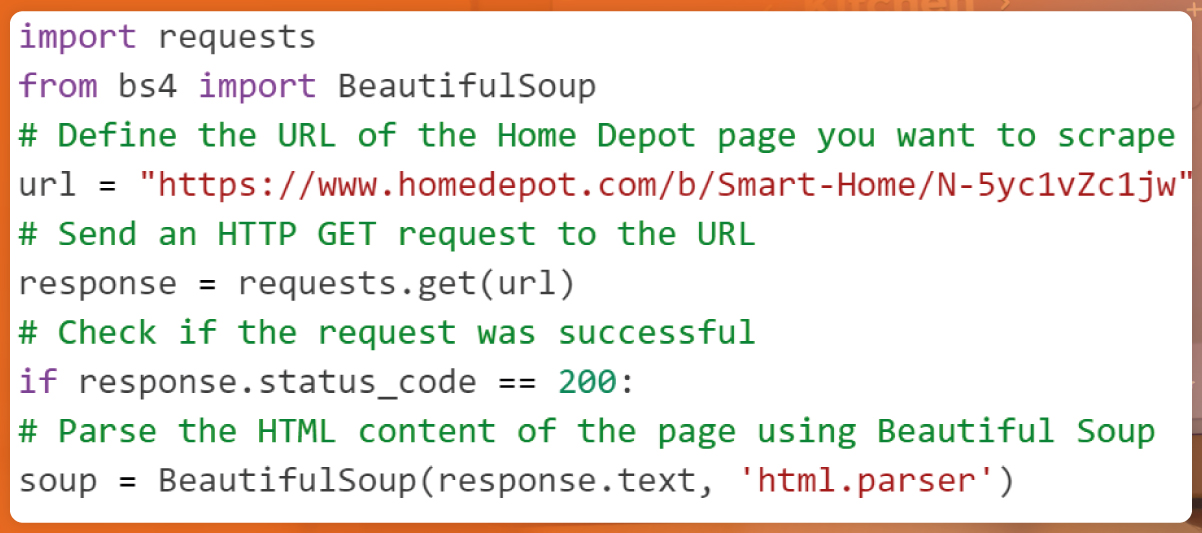

This code initializes the web scraping process by sending an HTTP request to the Home Depot page with smart devices and then uses Beautiful Soup to parse the HTML content. It demonstrates how to extract product names as a starting point.
To further enhance your web scraping project, you can extend the code to extract additional attributes, implement rate limiting, and handle errors or exceptions. Additionally, consider automating and scheduling the scraping process if you need to collect data regularly.
Obtaining Product Links: Initiation of Web Scraping Process
To extract product links from a webpage, you can use Python and libraries such as Beautiful Soup. Here’s a code example for getting the products’ links from a Home Depot page featuring smart devices:
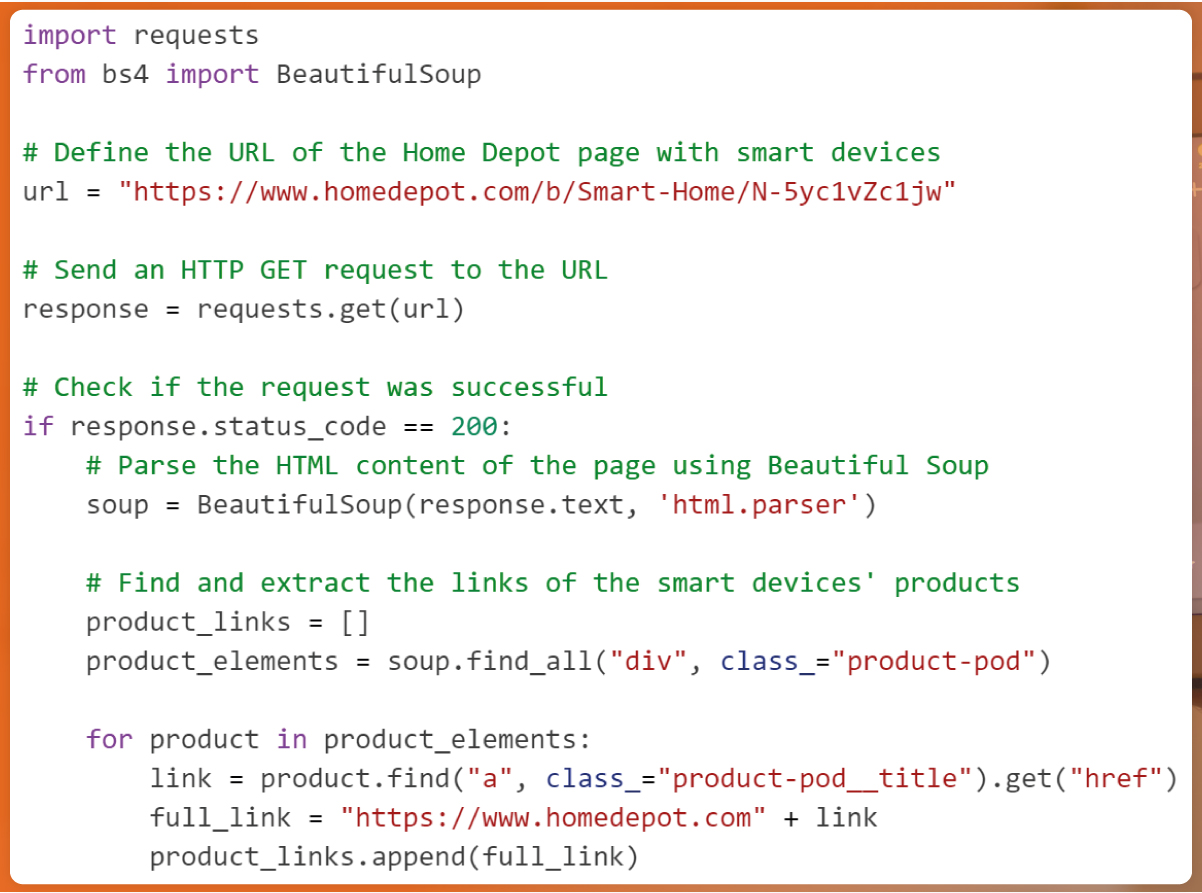


This code sends an HTTP GET request to the Home Depot page with smart devices and extracts the links of the product pages. It creates a list of product links and prints them.
You can adapt and extend this code to scrape more product details, automate the data collection, and store the links for further use in your web scraping project.
Creating Modular Functions for Web Scraping Tasks
Defining functions in your web scraping project can modularize your code, making it more organized and easier to maintain. Here’s an example of defining a function in Python to extract product links from a Home Depot page featuring smart devices:
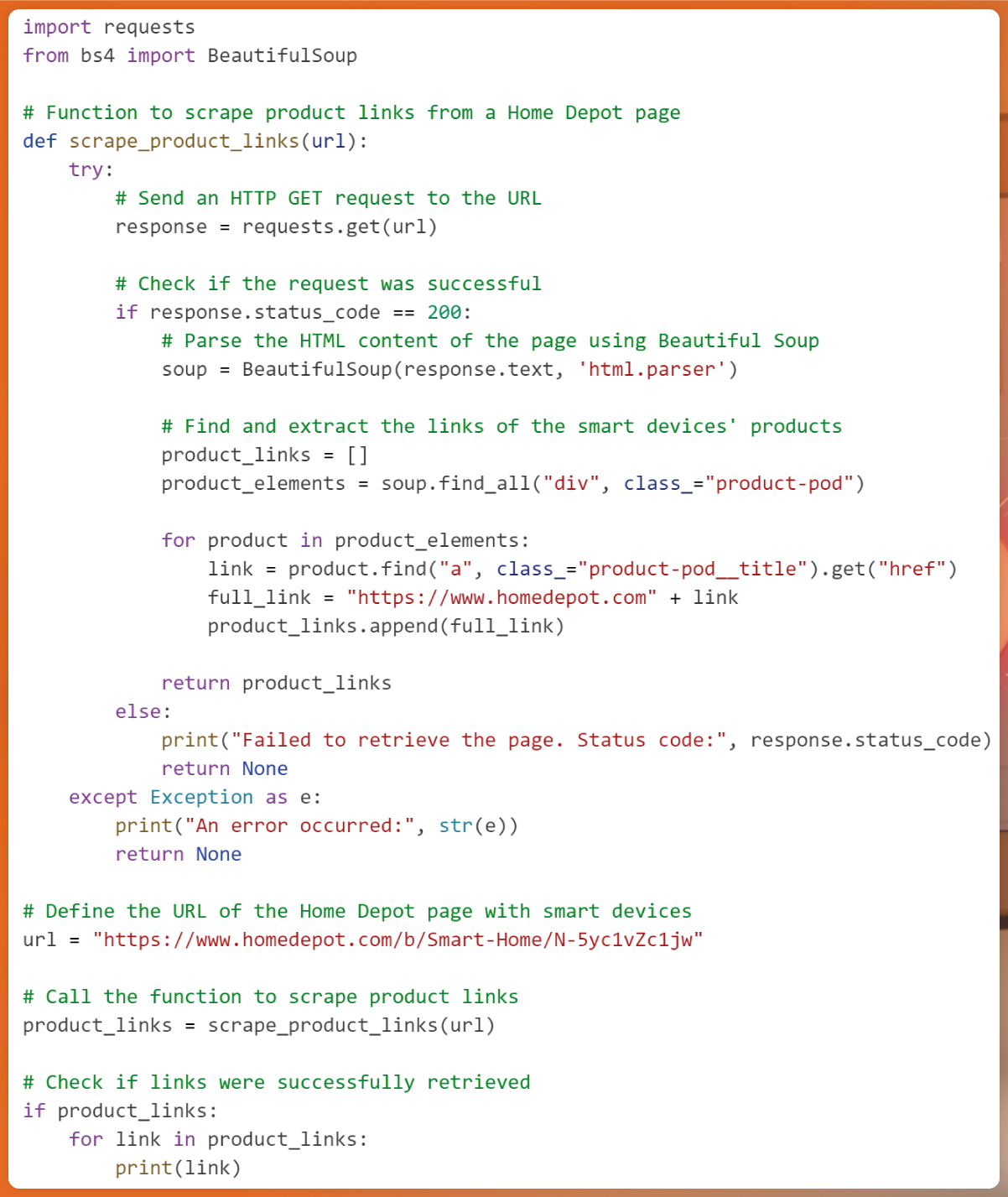
In this code, the scrape_product_links function encapsulates the web scraping logic for retrieving product links. You pass the URL as an argument to the function, and it returns the list of product links. This modular approach makes it easier to reuse this function for multiple pages or scraping tasks within your project. It also helps handle exceptions and errors gracefully.
You can define additional functions for various aspects of your web scraping project to keep your code organized and maintainable.
Storing Information in a CSV File Using Python
To write data to a CSV file in Python, you can use the csv module. Here’s an example of how to write data to a CSV file using this module:
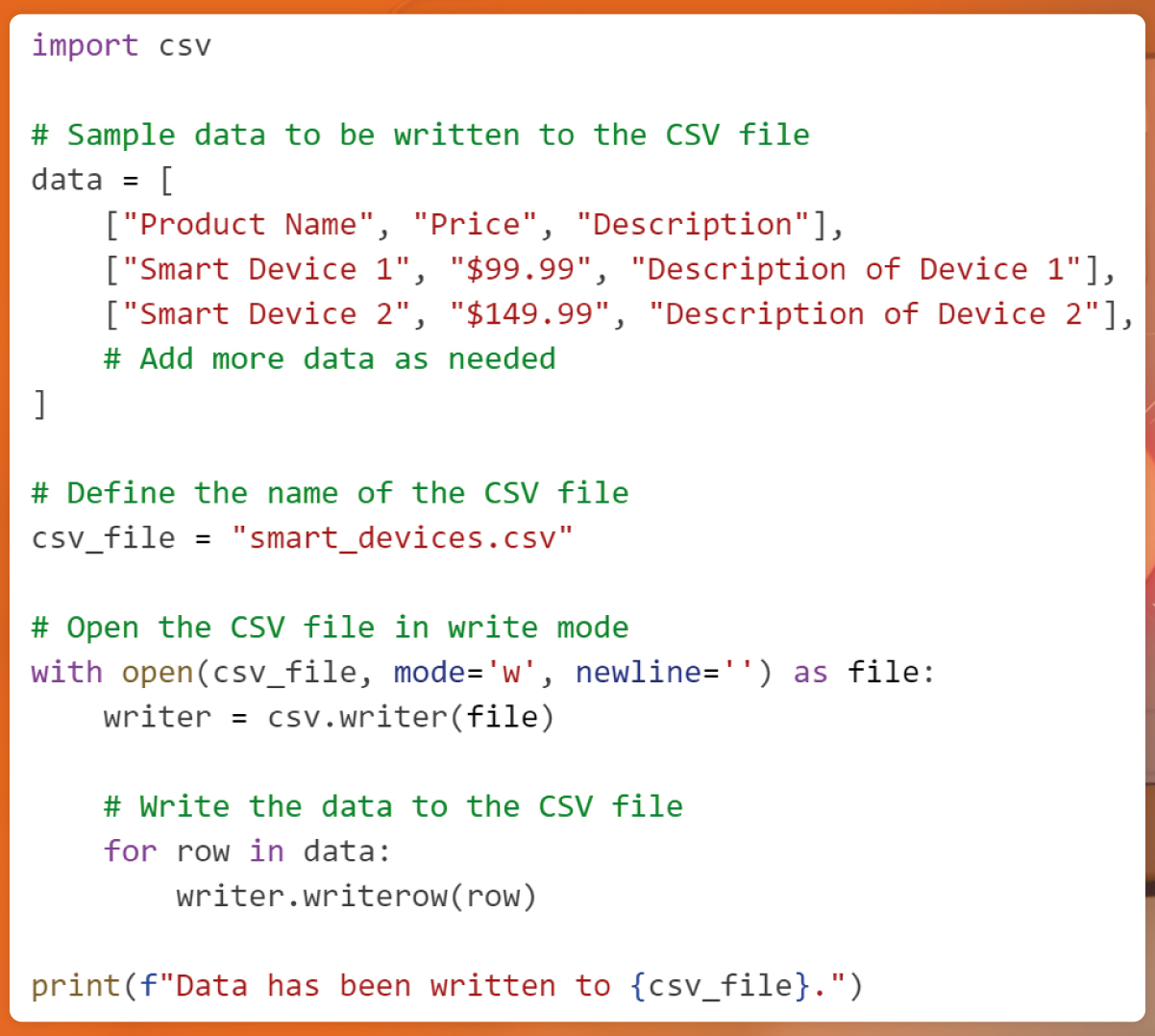
In this code:
We define a list of data containing the data you want to write to the CSV file.
We specify the name of the CSV file as csv_file.
We open the CSV file in write mode using the open function with the ‘w’ mode and specify newline=” to ensure proper line endings.
We create a CSV writer object with csv.writer(file).
We loop through the data list and use the writerow method to write each row to the CSV file.
Finally, we print a message to confirm that the data has been written to the CSV file.
You can replace the sample data with the data you want to write to the CSV file in your web scraping project. This code can be integrated into your existing web scraping script to store the scraped data in a CSV file for further analysis or reporting.
Conclusion
Scraping valuable product data from Home Depot through web scraping is a gateway to data-driven success. Whether you seek to stay informed as a consumer, optimize pricing and inventory as a business, or conduct insightful market research, this process is indispensable. However, ethical and legal compliance is paramount. Actowiz Solutions offers a custom-tailored web scraping API, ensuring efficient, accurate, and responsible data collection. By harnessing their services, you can elevate your data-driven endeavors. As technology evolves, the significance of web scraping in accessing and utilizing e-commerce data remains steadfast, presenting a powerful tool for making informed decisions and gaining a competitive edge. You can also reach us for all your mobile app scraping, instant data scraper and web scraping service requirements.
SOURCES >> https://www.actowizsolutions.com/scrape-smart-devices-data-from-home-depot.php
tag : #ScrapeSmartDevicesData
#HomeDepotDataScraping
#HomeDepotDataCollection
#ScrapeHomeDepotData
#HomeDepotDataScraper

